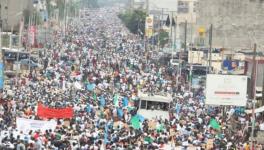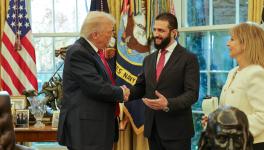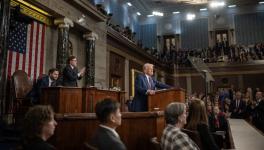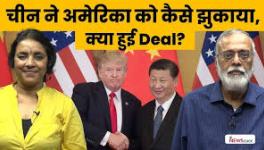Exxon, Essequibo and Imperialism

US Secretary of State Marco Rubio and Guyanese President Irfaan Ali. Photo: Irfaan Ali/X
US Secretary of State Marco Rubio recently traveled to Guyana where he threatened military action against Venezuela. Rubio’s statements have inflamed the tense border dispute between Venezuela and Guyana, creating fears of a broader conflict and continuing a long history of imperialist countries using differences over the border between the two countries to disrupt Latin American unity and economic cooperation.
Since the 18th century, both sides in what we now know as the “Venezuela-Guyana” border dispute have, for most of the time, agreed to disagree about the exact parameters of a border that, as one Guyanese diplomat put it is “[In practice]…a sort of free border, especially for the Amerindians…they do not really recognize ‘lines on the ground.’”
Occasionally, the right to exploit land and resources has caused tensions to flare. The current dispute has the same roots. The very location of the border is the child of various imperial expansion schemes; present tensions are also overshadowed by the plans of US imperialism. What makes the current iteration of the dispute particularly fraught is that it’s formally between two developing nations whose claims are both rooted in a context of anti-colonial resistance. It also has the added dimension of cutting across complex lines of race, ethnicity, and language.
The Guyanese government is drawing on powerful cultural artillery to advance claims of the Guyanese ruling class who have enlisted US imperialism as an ally. To resolve the issue as they want — a full acceptance of their territorial claims — can only have one result: to facilitate US efforts to isolate Venezuela, strangle it economically, and overthrow the socialist Bolivarian revolution. This would be a catastrophic setback to the overall struggle against imperialism and for socialism, which was renewed in the 21st century by the rise of the Bolivarian revolution.
That being said, the Guyanese territorial claims are long-standing and rooted in the contours of the nation that emerged from the struggle against British colonialism. That is why the government of Guyana is able to mobilize popular support around the issue. Relatedly, for Venezuelans this is also an issue rooted in the long struggle to assert itself against British imperialism and thus a significant factor in national identity. Even more, for both peoples, Essequibo is an important historical site of Indigenous and slave resistance that are core parts of the identity of the Bolivarian socialist trend and the Guyanese national liberation struggle.
Yet, the current situation is undercut by US imperial meddling, which blocks the possibility for sovereign solutions. To understand what is happening today requires a deeper understanding of how the dispute developed and how powerful forces have tried to manipulate the issue both historically and today.
Zone of Contestation
The Spanish were the first European power to come to the Essequibo region, but the Dutch were the first to set up a system of slave labor to secure their territory. The exact border remained undefined because of the resistance of the Carib people who were able to use the dense rainforests to stave off European encroachment. To weaken the Dutch, the Spanish offered freedom to slaves who escaped to their settlements. The Dutch responded by offering an alliance to the Indigenous, which represented a means to survive and defend against Spanish raids, in exchange for acting as slave catchers.
With the Indigenous peoples and the terrain preventing effective control, the “border” remained amorphous with both sides claiming more territory than they actually controlled.
Thus, when the British took over the Dutch colonies in 1814, no border was demarcated. Starting with Bolivar, the newly independent Venezuelans were eager to cede as little territory as possible to the British Empire. The English, for most of the 19th century, brushed off the Venezuelan claims, and continued to settle people in the disputed area.
The Dispute Evolves
In the 1860s rich gold deposits were found within what was considered “Spanish Guyana” but the miners and the capital were mostly from Britain. Venezuela escalated the issue by granting US investors concessionary rights.
In 1886, Britain officially declared a western border along a line drawn by an explorer retained by the Crown who drew a line that roughly corresponds to the modern border (before the Venezuelan referendum). British ministers made it clear that in negotiations they would “make large abatements from her claim.” Noting further, that large swaths of its claims rested not on “settled districts” but “effective…general administration” of territories “neither actually used nor occupied.”
A flurry of diplomatic activity ensued, and Venezuela’s claims were subsumed by the United States. The US and UK agreed to a formal arbitration to settle the issue, with no Venezuelan involvement. Venezuela’s president referred to the arbitration deal as a “national humiliation” and the “the press and the politicians strongly criticized” the move.
Nonetheless, the US and England, with involvement from Russia, determined in 1899 that, with some limited modifications, the British assertion of where the border was would now be “internationally recognized.” Venezuela, however, almost immediately rejected the decision, maintaining its original claim, although ultimately, they had no means of pressing the issue, which lay mainly dormant until the 1960s.
A New Era
As the 60s opened, Guyana was hurtling towards independence under the leadership of the People’s Progressive Party (PPP). The PPP was part of the radical-leaning subset of the postwar wave of decolonization that swept the world after the Second World War. Washington worried that PPP would work with the Soviet bloc and tried to head-off a PPP victory in post-independence elections. Secretary of State Dean Rusk proposed to President Kennedy in July of 1962 to “encourage Venezuela…to pursue their territorial claims.” In November of 1962, Venezuela raised the claim in front of the U.N.
This led to negotiations between Venezuela, the United Kingdom, and the pro-Western leaders of British Guiana, just a few months from independence. The two sides signed the “Geneva Agreement” in 1966. The agreement resulted in a Venezuela-Guyana “mixed commission” to try to find a way to resolve the dispute.
The issue revived in the early 1980s where, as Hugo Chávez noted, the Venezuelan government “told us that Guyana was becoming another Cuba, that we had to invade them…They had us plan a whole invasion of Georgetown.” He noted further: “American officials came…to warmonger against Guyana” due to problems the US was having with Guyanese leader Forbes Burnham. The Venezuelan push fizzled and the issue did not again arise until after the Bolivarian revolution took power.
The recent demagogic use of the border dispute by the Venezuelan right-wing has raised fears among the Guyanese people about past manipulations of the border issue by the (non-socialist, non-progressive) Venezuelan governments of the past.
Guyana, Venezuela, Socialism and Imperialism
The current Venezuelan government position, however, is rooted in how the demarcation dispute relates to imperialism. Originally drawn to enrich British imperialism, the same line is now being used to facilitate US imperialist desire to assert control over the resources of both Venezuela and Guyana. Starting under Hugo Chavez, Venezuela attempted to tamp down the border issue and successfully pursued greater cooperation for precisely this reason, despite intrigues by US diplomats and Guyanese politicians.
Guyana joined Petrocaribe, which offered energy resources to Caribbean nations on favorable terms. Venezuela provided about half Guyana’s daily oil needs. Venezuela also purchased 40% of Guyana’s rice crop for, on average, 20% above market price.
As a result Guyana’s “Oil import bill was contained…its overall public debt has been effectively reduced…In addition, Guyana was able to conserve a significant amount of foreign exchange and accumulate more gross international reserves.”
However, as early as 2006, the US Embassy was reporting that Guyana was hoping to “have others apply the pressure on Venezuela” regarding the border dispute, noting that Guyana had at various times “requested that the USG [US government] and UK issue statements affirming the 1899 settlement.”
In 2007, the year Guyana joined Petrocaribe, President Bharrat Jagdeo told the US ambassador that “he is encouraging foreign oil companies to begin exploring along both of Guyana’s contested borders — with Suriname and Venezuela.” He added that Chavez’s socialist approach “toward private investors was reckless and not sustainable.” And that Guyana was “investor friendly.” The following year major oil companies “began exploring the waters offshore Guyana in earnest.” The ambassador added he felt Jagdeo “wants the oil companies,” and implicitly their international protection, “to test Venezuela’s sensitivity” on the border issue.
According Guyanese officials, as early as 2009 they were drawing up plans to extend their Exclusive Economic Zone to subsume oil rich areas in disputed territory. In 2011, Guyana applied to the UN for the extension. Negotiations – led on the Venezuelan side by Nicolas Maduro – managed to keep the issue cool for another two years until 2013 when Venezuela seized ships exploring for oil in this disputed maritime territory.
In 2015 Guyana granted an oil license to Exxon in the disputed area. In 2018, the then Guyanese Natural Resources minister told reporters that “We may wish to…sell our oil, as Venezuela had done, to our CARICOM brothers and sisters…That may have some value strategically as well.” This idea is also in circulation among the US right wing.
In 2019 Exxon started shipping oil. The Exxon-government combine quickly integrated most of the relevant press corps into corporate public relations and state-run newsrooms. A lawyer trying to file a case against Exxon had to go to Trinidad to obtain counsel “given how many firms Exxon and its partners, subsidiaries, and suppliers have contracted with in Guyana.”
The dispute accelerated further in September of 2023 when Guyana granted six more drilling licenses, including more to Exxon, in the disputed territory, which prompted Venezuela to announce a consultative referendum in response. In the interim, the U.N. Secretary General has also asked the International Court of Justice to rule on the 1899 demarcation.
The Guyanese government has presented the issue as part of a development push. However, even the IMF thought arrangements with Exxon were “exceedingly generous to ExxonMobil.” In 2018 the government that negotiated the deal fell in a vote of no-confidence linked to widespread anger about the terms in the country, as well as one ruling party lawmaker who voted against the government due to pressure from thousands of sugar workers who had been protesting over being sacked during an austerity push. Current Guyanese leader Irfaan Ali, despite benefiting from the vote of no-confidence, declared his party would not renegotiate the deal with Exxon.
Popular organizations have continued to push for renegotiation, demanding a referendum on the issue and recently 94% of Guyanese people told pollsters they want to see a renegotiation of the deal. However Guyana’s main political parties have yet to commit to taking any action on this overwhelming desire for greater royalties and tax revenues from Exxon.
As elections approach this year, President Ali has also rushed out one-time cash transfers, reinstated free college tuition and funded infrastructure projects to stave off criticism of Guyana’s deal with Exxon. But doubts remain about Ali’s commitment to truly developing the nation. As one Guyanese activist noted in terms of promises of oil lifting the country out of poverty:
“Where is the money from the gold? Where is the money from the bauxite? Where is the money from the diamonds? Where is the money from the sugar? Where is the money from the agriculture? Where is the money from the fishing, etc.? The list is almost endless because we are so full of wealth, and yet the people in this country are poor.”
Resist Imperialism
The record reflects that since 2006 various Guyanese governments have looked to exploit US animosity towards Venezuela to obtain access to oil resources. Ominously General Laura Richardson, head of the US Southern Command (SOUTHCOM), stated in a recent Congressional hearing that Guyana, a “very willing partner,” needs a larger US embassy and expanded US military presence to help “channel and guide them with all these new additional resources.”
Rubio’s visit, and threats to Venezuela, coincided with US-Guyana naval exercises. Rubio, pointedly, noted on his trip that the US has a “big Navy,” “ongoing commitments to Guyana” and would not hesitate to deliver “consequences” to Venezuela, in defense of Exxon’s oil rigs.
Despite the tensions, it’s important to note that the worst has been averted several times in the recent past through dialogue, something supported by the region, where St. Vincent and The Grenadines, Brazil, Cuba and CARICOM have worked in a cooperative framework with Venezuela and Guyana to find a solution.
Venezuela has used its oil wealth to pursue significant development goals and disrupt US hegemony in Latin America. This is exactly what led to the country coming into the US crosshairs. Keeping the two nations divided and trying to weaponize Guyanese oil is a US strategy to keep Latin America in a dependent state. This makes it incumbent upon socialists in the United States to make clear that US imperialism has no business meddling in Latin American politics.
Courtesy: Peoples Dispatch
Get the latest reports & analysis with people's perspective on Protests, movements & deep analytical videos, discussions of the current affairs in your Telegram app. Subscribe to NewsClick's Telegram channel & get Real-Time updates on stories, as they get published on our website.
























